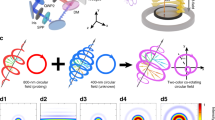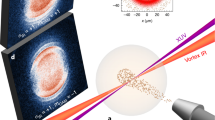Abstract
The interaction between a quantum particle’s spin angular momentum1 and its orbital angular momentum2 is ubiquitous in nature. In optics, the spin–orbit optical phenomenon is closely related with the light–matter interaction3 and has been of great interest4,5. With the development of laser technology6, the high-power and ultrafast light sources now serve as a crucial tool in revealing the behaviour of matter under extreme conditions. A comprehensive knowledge of the spin–orbit interaction for intense light is of utmost importance. Here, we report the in situ modulation and visualization of the optical orbital-to-spin conversion in the strong-field regime. We show that, through manipulating the morphology of femtosecond cylindrical vector vortex pulses7 by a slit, the photon’s orbital angular momentum can be controllably transformed into spin after focusing. By employing a strong-field ionization experiment, the orbital-to-spin conversion can be imaged and measured through the photoelectron momentum distributions. Such detection and consequent control of the spin–orbit dynamics of intense laser fields has implications for controlling photoelectron holography and coherent extreme-ultraviolet radiation8.
This is a preview of subscription content, access via your institution
Access options
Access Nature and 54 other Nature Portfolio journals
Get Nature+, our best-value online-access subscription
$29.99 / 30 days
cancel any time
Subscribe to this journal
Receive 12 print issues and online access
$209.00 per year
only $17.42 per issue
Buy this article
- Purchase on Springer Link
- Instant access to full article PDF
Prices may be subject to local taxes which are calculated during checkout




Similar content being viewed by others
Data availability
The data that support the plots within this paper and other findings of this study are available from the corresponding author upon reasonable request.
References
Beth, R. Mechanical detection and measurement of the angular momentum of light. Phys. Rev. 50, 115–125 (1936).
Allen, L., Beijersbergen, M. W., Spreeuw, R. J. C. & Woerdman, J. P. Orbital angular momentum of light and the transformation of Laguerre-Gaussian laser modes. Phys. Rev. A 45, 8185–8189 (1992).
Bliokh, K. Y., Rodríguez-Fortuño, F. J., Nori, F. & Zayats, A. V. Spin–orbit interactions of light. Nat. Photon. 9, 796–808 (2015).
Rechcinska, K. et al. Engineering spin-orbit synthetic Hamiltonians in liquid-crystal optical cavities. Science 366, aay4182 (2019).
Shao, Z. K. et al. Spin-orbit interaction of light induced by transverse spin angular momentum engineering. Nat. Commun. 9, 926 (2018).
Li, W. et al. 339 J high-energy Ti:sapphire chirped-pulse amplifier for 10 PW laser facility. Opt. Lett. 43, 5681–5684 (2018).
Zhao, Z., Wang, J., Li, S. & Willner, A. E. Metamaterials-based broadband generation of orbital angular momentum carrying vector beams. Opt. Lett. 38, 932–934 (2013).
Dorney, K. M. Controlling the polarization and vortex charge of attosecond high-harmonic beams via simultaneous spin–orbit momentum conservation. Nat. Photon. 13, 123–130 (2019).
Yao, A. M. & Padgett, M. J. Orbital angular momentum: origins, behavior and applications. Adv. Opt. Photon. 3, 161–204 (2011).
Shitrit, N. et al. Spin-optical metamaterial route to spin-controlled photonics. Science 340, 724–726 (2013).
Haefner, D., Sukhov, S. & Dogariu, A. Spin Hall effect of light in spherical geometry. Phys. Rev. Lett. 102, 123903 (2009).
Zhao, Y., Edgar, J. S., Jeffries, G. D. M., McGloin, D. & Chiu, D. T. Spin‑to‑orbital angular momentum conversion in a strongly focused optical beam. Phys. Rev. Lett. 99, 073901 (2007).
Fu, S. et al. Spin-orbit optical Hall effect. Phys. Rev. Lett. 123, 243904 (2019).
Araneda, G. et al. Wavelength-scale errors in optical localization due to spin–orbit coupling of light. Nat. Phys. 15, 17–21 (2019).
Pan, D., Wei, H., Gao, L. & Xu, H. Strong spin-orbit interaction of light in plasmonic nanostructures and nanocircuits. Phys. Rev. Lett. 117, 166803 (2016).
Han, L. et al. Catalystlike effect of orbital angular momentum on the conversion of transverse to three-dimensional spin states within tightly focused radially polarized beams. Phys. Rev. A 97, 053802 (2018).
Li, M. et al. Orbit-induced localized spin angular momentum in strong focusing of optical vectorial vortex beams. Phys. Rev. A 97, 053842 (2018).
Yu, P., Zhao, Q., Hu, X., Li, Y. & Gong, L. Orbit-induced localized spin angular momentum in the tight focusing of linearly polarized vortex beams. Opt. Lett. 43, 5677–5680 (2018).
Nechayev, S., Eismann, J. S., Leuchs, G. & Banzer, P. Orbital-to-spin angular momentum conversion employing localized helicity. Phys. Rev. B 99, 075155 (2019).
Mulser, P. & Bauer, D. High Power Laser-Matter Interaction (Springer Science & Business Media, 2010).
Corkum, P. B. Plasma perspective on strong-field multiphoton ionization. Phys. Rev. Lett. 71, 1994–1997 (1993).
Tsesses, S., Cohen, K., Ostrovsky, E., Gjonaj, B. & Bartal, G. Spin−orbit interaction of light in plasmonic lattices. Nano Lett. 19, 4010–4016 (2019).
Ullrich, J. et al. Cold target recoil ion momentum spectroscopy. J. Phys. B 30, 2917–2974 (1997).
Youngworth, K. S. & Brown, T. G. Focusing of high numerical aperture cylindrical-vector beams. Opt. Express 7, 77–87 (2000).
Chávez-Cerda, S. et al. Holographic generation and orbital angular momentum of high-order Mathieu beams. J. Opt. B 4, S52–S57 (2002).
Cardano, F., Karimi, E., Marrucci, L., de Lisio, C. & Santamato, E. Generation and dynamics of optical beams with polarization singularities. Opt. Express 21, 8815–8820 (2013).
Ammosov, M. V. et al. Tunnel ionization of complex atoms and of atomic ions in an alternating electromagnetic field. Sov. Phys. JETP 64, 1191–1194 (1986).
Liu, M.-M. et al. Energy- and momentum-resolved photoelectron spin polarization in multiphoton ionization of Xe by circularly polarized fields. Phys. Rev. Lett. 120, 043201 (2018).
Goreslavski, S. P., Paulus, G. G., Popruzhenko, S. V. & Shvetsov-Shilovski, N. I. Coulomb asymmetry in above-threshold ionization. Phys. Rev. Lett. 93, 233002 (2004).
Li, M. et al. Classical-quantum correspondence for above threshold ionization. Phys. Rev. Lett. 112, 113002 (2014).
Bauer, T. et al. Observation of optical polarization Möbius strips. Science 347, 964–966 (2015).
Beresna, M., Gecevičius, M. & Kazansky, P. G. Polarization sensitive elements fabricated by femtosecond laser nanostructuring of glass. Opt. Mater. Express 1, 783–795 (2011).
Oemrawsingh, S. S. R. et al. Production and characterization of spiral phase plates for optical wavelengths. Appl. Opt. 43, 688–694 (2004).
Shao, Y. et al. Isolating resonant excitation from above-threshold ionization. Phys. Rev. A 92, 013415 (2015).
Berry, M. V. Paraxial beams of spinning light. In Int. Conf. Singular Optics (ed. Soskin, M. S.) Vol. 3487, 6–11 (SPIE, 1998).
Aiello, A., Banzer, P., Neugebauer, M. & Leuchs, G. From transverse angular momentum to photonic wheels. Nat. Photon. 9, 789–795 (2015).
Minkowski, H. Die Grundgleichungen für die elektromagnetischen Vorgänge in bewegten Körpern. Math. Ann. 68, 472–525 (1910).
O’Neil, A. T., MacVicar, I., Allen, L. & Padgett, M. J. Intrinsic and extrinsic nature of the orbital angular momentum of a light beam. Phys. Rev. Lett. 88, 053601 (2002).
Perelomov, A. M., Popov, V. S. & Terentev, M. V. Ionization of atoms in an alternating electric field. Sov. Phys. JETP 23, 924–934 (1966).
Acknowledgements
We thank finance support by the National Science Foundation of China (grant numbers: 92050201, 918850111, 11774013, 11625414).
Author information
Authors and Affiliations
Contributions
Y.F. and Z.G. performed the experiments. Y.F. and Y.L. analysed and interpreted the data. Simulations were performed by Y.F. and M.H. This project was coordinated by Y.L. All authors discussed the results and wrote the paper.
Corresponding author
Ethics declarations
Competing interests
The authors declare no competing interests.
Additional information
Publisher’s note Springer Nature remains neutral with regard to jurisdictional claims in published maps and institutional affiliations.
Supplementary information
Supplementary Information
Supplementary Figs. 1–3 and Discussion (five sections).
Rights and permissions
About this article
Cite this article
Fang, Y., Han, M., Ge, P. et al. Photoelectronic mapping of the spin–orbit interaction of intense light fields. Nat. Photonics 15, 115–120 (2021). https://doi.org/10.1038/s41566-020-00709-3
Received:
Accepted:
Published:
Issue Date:
DOI: https://doi.org/10.1038/s41566-020-00709-3
This article is cited by
-
Orbital angular momentum lasers
Nature Reviews Physics (2024)
-
Spin-orbit Rabi oscillations in optically synthesized magnetic fields
Light: Science & Applications (2023)
-
Structured air lasing of N2+
Communications Physics (2023)
-
Non-destructive OAM measurement via light–matter interaction
Light: Science & Applications (2022)
-
Probing the orbital angular momentum of intense vortex pulses with strong-field ionization
Light: Science & Applications (2022)



